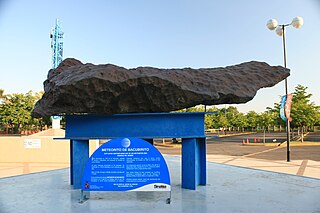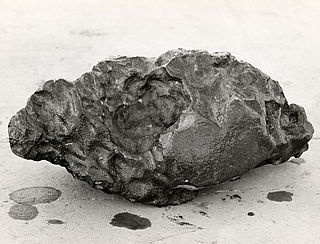 W
WIron meteorites, also known as siderites, or ferrous meteorites, are a type of meteorites that consist overwhelmingly of an iron–nickel alloy known as meteoric iron that usually consists of two mineral phases: kamacite and taenite. Iron meteorites originate from cores of planetesimals.
 W
WThe Bacubirito meteorite is the largest meteorite found in Mexico, the third largest in the Americas and the sixth largest in the world. Found in 1863 by the geologist Gilbert Ellis Bailey in the village of Ranchito near the town of Sinaloa de Leyva, it is an iron meteorite weighing between 20 and 22 tonnes. It measures 4.25 meters long, 2 meters wide, and 1.75 meters high.
 W
WThe Bear Creek meteorite, formerly known as the Colorado meteorite, is an octahedrite meteorite that was found in 1866 in Jefferson County, Colorado, United States. It has a mass of 226.7 kg (500 lb) and average dimensions of 350 mm × 250 mm × 11 mm.
 W
WThe Bendegó Meteorite is a meteorite found in the interior of the state of Bahia, Brazil. It is the biggest iron meteorite ever found in Brazilian soil, weighting 5,360 kilograms (11,820 lb). It has been on display at the National Museum of Brazil, in Rio de Janeiro, since 1888.
 W
WBlock Island meteorite, officially named Meridiani Planum 006 shortened as MP 006, was found on Mars by the Opportunity rover on July 17, 2009. It is about 67 centimetres (26 in) across.
 W
WCampo del Cielo refers to a group of iron meteorites and to the area in Argentina where they were found. The site straddles the provinces of Chaco and Santiago del Estero, 1,000 kilometers (620 mi) north-northwest of Buenos Aires, Argentina. It is half that distance, north-east, to Paraguay's capital, Asunción. The crater field covers 3 by 18.5 kilometres and contains at least 26 craters, the largest being 115 by 91 metres.
 W
WThe Canyon Diablo meteorites include the many fragments of the asteroid that created Barringer Crater, Arizona, United States. Meteorites have been found around the crater rim, and are named for nearby Canyon Diablo, which lies about three to four miles west of the crater.
 W
WThe Cape York meteorite, also known as the Innaanganeq meteorite, is one of the largest known iron meteorites, classified as a medium octahedrite in chemical group IIIAB. In addition to many small fragments, at least eight large fragments with a total mass of 58 tons have been recovered, the largest weighing 31 tonnes. The meteorite is loosely named after the location where the largest fragment was found: 23 miles (37 km) east of Cape York, in Savissivik, Meteorite Island, Greenland.
 W
WThe Chinga meteorite is an iron meteorite. It is structurally an ataxite with very rare kamacite lamella. The meteoric iron is a part of the lamella taenite. The total chemical composition is 82.8% iron, 16.6% nickel, and the rest mostly cobalt and phosphorus.
 W
WThe Coahuila meteorite is a hexahedrite iron meteorite found in Coahuila, Mexico. The large number of fragments has led to many synonyms and many authors think that more than one meteorite is represented by the fragments. Only fragments found in Coahuila, that are hexahedrites and fall into the IIAB group should be called Coahuila meteorite.
 W
WThe Cranbourne meteorite is an octahedrite iron meteorite. It is the second largest meteorite found in Australia after the Mundrabilla meteorite, but at the time of discovery it was the largest known iron meteorite in the world. It is classified as a main group IAB meteorite.
 W
WThe Dronino meteorite is a 40-kilogram (88 lb) iron meteorite that was found in the Ryazan Oblast of Russia in July 2000. It is classified as an ataxite.
 W
WElbogen, also the Loket Iron, is an iron meteorite that fell in the village of Loket, Karlovy Vary Region, Kingdom of Bohemia, about the year 1400. Also known during the Middle Ages as the "bewitched burgrave" of Elbogen, due to a cursed Count at the Elbogen castle, it is the oldest of 15 recorded falls in the Czech Republic. It has not survived to our time in its original size, having been cut for scientific purposes and its pieces sent to museums all around the world.
 W
WGebel Kamil is a meteorite that struck Egypt about 5000 years ago leaving a crater surrounded by thousands of pieces of iron shrapnel with a total weight of about 1,600 kilograms (3,500 lb).
 W
WGibeon is a meteorite that fell in prehistoric times in Namibia. It was named after the nearest town: Gibeon.
 W
WThe Goose Lake meteorite is a meteorite that was found at Goose Lake in the United States by two hunters from Oakland, California on October 13, 1938.
 W
WThe Grant Meteorite is a meteorite that was discovered in the Zuni Mountains, about 45 miles (72 km) south of Grants, New Mexico. It was unearthed in 1929 although the date of its original groundfall is unknown.
 W
WHeat Shield Rock is a basketball-sized iron-nickel meteorite found on the Meridiani Planum plain of Mars by the Mars rover Opportunity in January 2005.
 W
WThe Hoba meteorite, short for Hoba West, is a meteorite that lies on the farm of the same name, not far from Grootfontein, in the Otjozondjupa Region of Namibia. It has been uncovered but, because of its large mass, has never been moved from where it fell. The main mass is estimated at more than 60 tonnes. It is the largest known intact meteorite and about twice as massive as the largest fragment of either the Cape York meteorite's 31-tonne Ahnighito kept in Manhattan or the Campo del Cielo's 31-tonne Gancedo in Argentina. It is also the most massive naturally occurring piece of iron known on Earth's surface. The name "Hoba" comes from Khoekhoegowab word meaning "gift". It saw, on donation to the government, in 1987, its visitor centre's construction and its circular stone seating/steps area.
 W
WHraschina is the official name of an iron meteorite that fell in 1751 near the Hrašćina village in Hrvatsko Zagorje, Croatia. This meteorite is important because it was the first fall of an iron meteorite viewed and reported by a significant number of witnesses, despite its low remaining total known weight. The Hraschina meteorite also proved that rocks really can "fall from the skies".
 W
WThe Loreto is a meteorite that was found in Baja California Sur, Mexico. It was found in 1896 and weighed approximately 95 kilograms (209 lb).
 W
WMackinac Island meteorite was found on Mars by the Opportunity rover on October 13, 2009.
 W
WMbozi is an ungrouped iron meteorite found in Tanzania. It is one of the world's largest meteorites, variously estimated as the fourth-largest to the eighth-largest, it is located near the city of Mbeya in Tanzania's southern highlands. The meteorite is 3 metres (9.8 ft) long, 1 metre high, and weighs an estimated 16 metric tons.
 W
WThe Mundrabilla meteorite is an iron meteorite found in 1911 in Australia, one of the largest meteorites found, with a total known weight of 22 tonnes and the main mass accounting for 12.4 tonnes.
 W
WThe Muonionalusta meteorite is a meteorite classified as fine octahedrite, type IVA (Of) which impacted in northern Scandinavia, west of the border between Sweden and Finland, about one million years BCE.
 W
WThe Nantan meteorite is an iron meteorite that belongs to the IAB group and the MG subgroup.
 W
WOileán Ruaidh is a rock discovered on Mars in September 2010 by the Opportunity rover. It is a 45 centimeter wide dark rock thus it is thought to be an iron meteorite. It was given the name Oileán Ruaidh after the Irish language name of Oileán Ruaidh island in County Donegal in Ireland.
 W
WThe Old Woman Meteorite is the largest meteorite found in California and the second largest in the United States. It was discovered in the Old Woman Mountains in southern California in late 1975. It is 38 inches (970 mm) long, 34 inches (860 mm) high, and 30 inches (760 mm) wide. The meteorite is mostly composed of iron, but also contains nickel, as well as small amounts of chromium, cobalt, phosphorus, and sulfur.
 W
WShelter Island meteorite was found on Mars by the Opportunity rover on October 1, 2009. It is about 27 centimetres (11 in) long.
 W
WAn iron meteorite fell on the Sikhote-Alin Mountains, in southeastern Russia, in 1947. Large iron meteorite falls have been witnessed and fragments recovered but never before, in recorded history, a fall of this magnitude. An estimated 23 tonnes of fragments survived the fiery passage through the atmosphere and reached the Earth.
 W
WThe Tlacotepec meteorite is an iron meteorite classified as an IVB meteorite. It is the only meteorite of the IVB group that is an octahedrite.
 W
WToluca is an iron meteorite found in 1776 in Mexico near Toluca.
 W
WThe Tucson Ring meteorite is a brezinaite meteorite fragment, first described by Bunch and Fuchs. It was reported as one of several masses of virgin iron found at the foot of the Sierra de la Madera and transported to the plaza of Tucson, Arizona circa 1850, where it was used as an anvil in a blacksmith's shop.
 W
WThe Willamette Meteorite, officially named Willamette and originally known as Tomanowos by the Clackamas Chinook Native American tribe is an iron-nickel meteorite found in the U.S. state of Oregon. It is the largest meteorite found in North America and the sixth largest in the world. There was no impact crater at the discovery site; researchers believe the meteorite landed in what is now Canada or Montana, and was transported as a glacial erratic to the Willamette Valley during the Missoula Floods at the end of the last Ice Age. It has long been held sacred by indigenous peoples of the Willamette Valley, including the federally recognized Confederated Tribes of the Grand Ronde Community of Oregon (CTGRC).
 W
WThe Yardymly meteorite is an iron meteorite that fell in Yardymli Rayon, Azerbaijan on November 24, 1959. The remains were discovered in the nearby village of Aroos. With five individual specimens, the total weight of the meteorite is estimated at 150.29 kilograms (331.3 lb). The meteorite is kept in the Institute of Geology of Azerbaijan National Academy of Sciences. According to the director of Şamaxı Astrophysical Observatory Eyub Guliyev, the Yardymli meteorite may originate from the shower of Perseids.